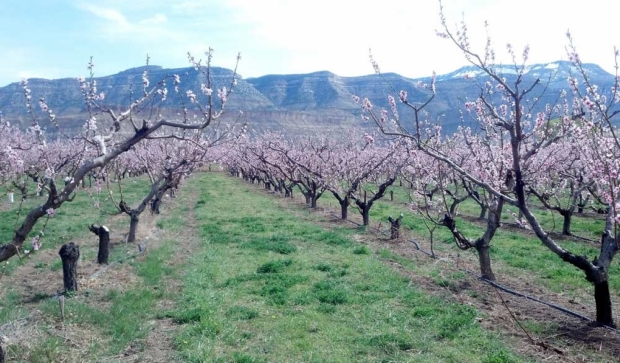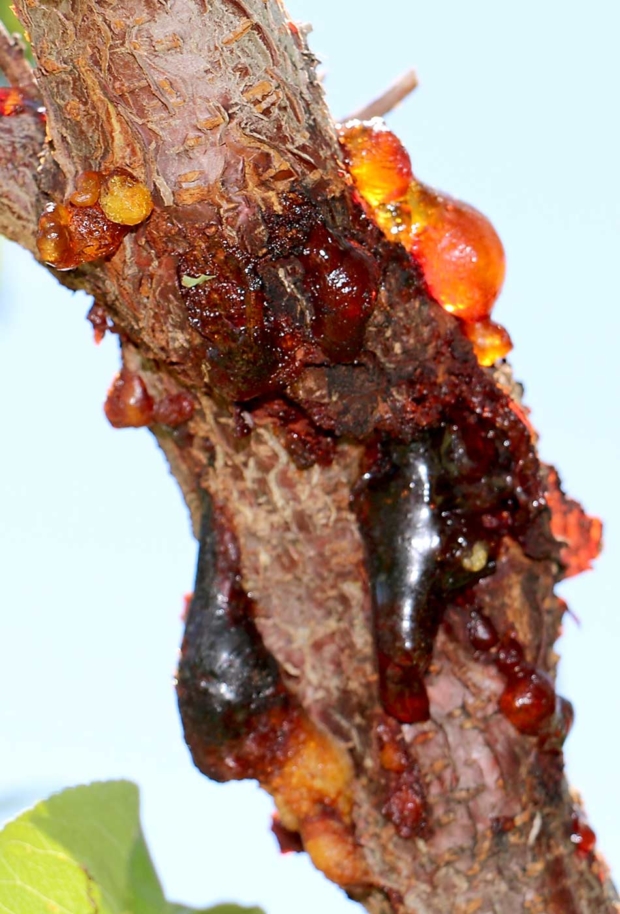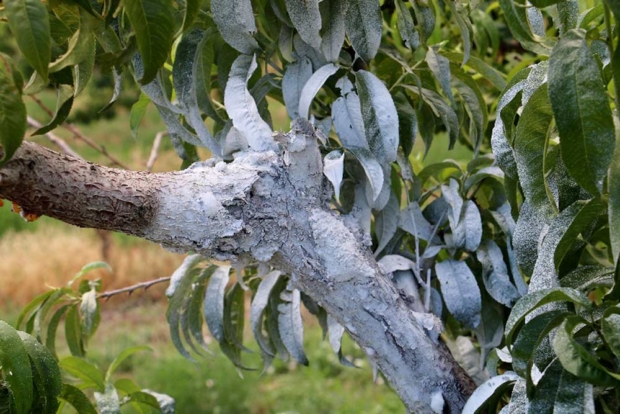
In the sunny mountain valleys of Western Colorado, a typically tame pathogen has become a big problem for the state’s $30 million peach industry.
Cytospora canker, sometimes called gummosis for the brown ooze produced at the infection site, slows growth and girdles branches.
In most regions, regular pruning will keep the canker in check, but in Colorado — for reasons still under investigation — it’s become an epidemic that’s cutting short the productive life of many orchards.
The severity of the infection has reached a critical level: 100 percent of orchards in the Grand Valley surveyed by Colorado State University scientists in 2015 were infected.

In some orchards, just a few trees might be infected, but in many, a majority of the trees are losing branches to the canker.
Because cytospora is a minor pest elsewhere, growers and researchers had to start from scratch in search of solutions, but their fledgling program is already pointing toward promising control practices.
“It has become this epidemic,” CSU pathologist Jane Stewart said. “There hadn’t been this push in the past to find something that cures it, but we have to.”
Researchers estimate the canker is causing 15 to 20 percent annual losses, said pomologist Ioannis Minas, who joined the CSU Western Colorado Research Center in 2015.
“The orchards here are not reaching their potential age; growers are removing orchards after four or five years if it gets really bad.”
Why is this weak pathogen becoming such an aggressive problem? Minas said it’s likely a confluence of factors, including that the Grand Valley, at 4,600 feet in elevation, has warm, sunny winter days and cold nights, increasing the likelihood of winter injury cracks that let cytospora creep into the tree.
Also, in recent years, growers may have unwittingly planted more susceptible varieties.
Once the pathogen is in the tree, there is no chemical control. Horticulturalists recommend pruning out infected branches immediately — but the pathogen has reached such epidemic levels that aggressive pruning would leave Colorado growers without many trees.
“The problem is that the trees that are infected, they produce pretty good peaches for about three years, so there is no incentive for growers to pull those trees out,” Stewart said.
Meanwhile, the pathogen appears to be producing spores year-round, ready to infect any new trees planted, she said. That means containment and prevention strategies are first on the research agenda.
“A good measure would be to remove all the trees, but economically, this is not a good measure,” Minas said. “We are trying to find applied solutions for them and trying to understand the physiology of this disease.”
From nuisance to epidemic
Colorado orchards have always had to contend with cytospora cankers, said Bruce Talbott, a fourth-generation grower in Palisade, billed as the state’s peach capital, who manages about 500 acres of mostly peaches and wine grapes.
But the disease has been increasingly prevalent in the last decade and particularly the past four years, after one unusually cold winter seemed to give the pathogen a boost.
“We’ve always lived with it, but it’s become by far our most significant problem,” Talbott said. “It accumulates and then you have missing trees and half trees and then you are at half production and it doesn’t make sense to continue. Last year, I took out a 6-year-old orchard and two 8-year-old orchards. There was no point in farming them because there wasn’t enough tree left.”
That threatens a business model built on orchards lasting about 20 years, he added.
In addition to the role of cold winters, Talbott believes that the new, firm red peach varieties from California that many Colorado growers have planted, such as Zee Lady and Sierra Rich, are particularly susceptible.
“In my opinion, that’s the background of what set us up,” he said. “Then, the proliferation of the disease has the inoculum level up so high that it’s now affecting the more resistant varieties, too.”
“My favorite peach is Zee Lady, but if I can’t keep it alive, there’s no point,” Talbott said, adding that he’s moving back to planting older varieties such as Redhaven, Glohaven and Suncrest, which seem to be more resistant to the canker.
Stewart said that the next phase of their research effort will be to identify which existing varieties offer the most resistance to the pathogen.
Initially, work has focused on finding chemicals that can protect healthy trees and figuring out the pathogen’s life cycle and behavior to best target control practices.
Much of that basic research about the pathogen hadn’t been done previously, because the disease has never been a significant problem in major peach growing regions such as the southeast, Stewart said.
Perhaps Colorado’s climate raises the risks for the pathogen, or the more intense fungicide regimes in the humid southeast might also help to keep cytospora in check.
Protection and prevention

Until recently, Larry Traubel, owner of the ag supply company CropwoRx, wasn’t sure what to recommend to growers trying to slow cytospora infection.
Like fire blight, the pathogen has been around forever and there is no cure, he said, but “now we’re getting closer to knowing how to slow it down or minimize it.”
Topsin, Captan and lime sulfur have emerged as the prime fungicide options for protecting pruning cuts and other wounds, Minas said. Cytospora is a weak pathogen, which means it needs a wound of some sort to get into the trees.
Traubel said some smaller growers are using paint to seal up pruning cuts, while larger growers are looking at a spray solution, such as latex mixed with water and Topsin.
But before CSU began its research, some growers were running their own experiments. Eric Favier, a French restaurateur who moved to Palisade in 2012 to help his father-in-law, John Cox, manage 35 acres of peaches, said he was shocked to see the cytospora damage was accepted by many growers as just a part of doing business here.
He decided to try his own experiments, inspired by the blue orchards — sprayed with Bordeaux mix — he remembered from growing up in France.
Workers spray the copper and lime sulfur mix after pruning, a relatively cheap application especially compared to the cost of the usual practice of pruning of infected wood. And it appears to be working, according to the scientists’ spore surveys.
“In my orchard, because of what we are doing with spraying the Bordeaux mix, the spore is not moving, he cannot detect it,” Favier said.
Minas said he couldn’t confirm Favier’s support for Bordeaux mix specifically because they didn’t test it. But they did find benefits from lime sulfur, so he assumes that’s what is working.
While his neighbors were initially skeptical about his experiments, Favier said several called this spring to learn more them. “And my father-in-law doesn’t give a lot of compliments, but he tells me that his orchard looks the best it has in 40 years,” Favier said.
The other key cultural practice, according to the CSU studies, is latex paint — or Surround for organic growers — which seals up existing cankers and “drastically reduces inoculum dispersal,” Minas said.
Keeping the spores in won’t help already infected trees, but it will reduce the risk of infection for new, healthy trees.
That’s the strategy Talbott adopted this year, painting pruning cuts and cankers with a 50-50 mix of latex paint and water, with some fungicide mixed in. He estimates that it costs about $100 an acre, on top of existing pest control costs of $300 to $400 an acre.
“Compared to the cost of losing orchards, if it’s effective, it’s not very expensive,” he said. Right now that’s still an if, but data gathered this season from Talbott, Favier and other cooperating growers should show how effective the practice is and how to fine-tune it.
Some growers remain skeptical, but interest is building. Favier chairs a cytospora working group that brings growers and researchers together to discuss solutions.
Future research will be funded with a $92,000 grant from the state, along with support from the local weed and pest control board in the Grand Valley.
Hopefully, their findings will benefit growers in other regions interested in controlling cytospora as well, Minas said. •
—by Kate Prengaman






Any Information on the root stock their using?
The majority of the industry was using Lovell and moving to prunus hybrids like Hansen 356 and Krymsk 86.